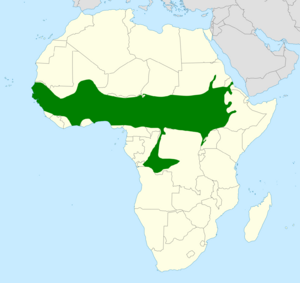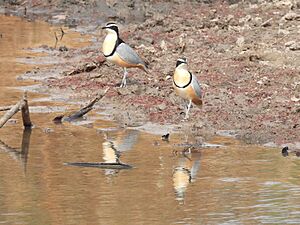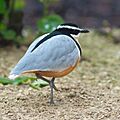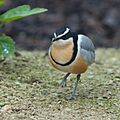Egyptian plover facts for kids
Quick facts for kids Egyptian plover |
|
|---|---|
 |
|
| Kaur Wetlands, the Gambia | |
| Conservation status | |
| Scientific classification | |
| Genus: |
Pluvianus
|
| Species: |
aegyptius
|
 |
|
| Range | |
| Synonyms | |
|
Charadrius aegyptius Linnaeus, 1758 |
|

The Egyptian plover (Pluvianus aegyptius) is a fascinating bird. It is also known as the crocodile bird. This unique wader is the only member of its special genus called Pluvianus. You can find it in a wide area across Sub-Saharan Africa. This range stretches from Senegal in the west to Ethiopia in the east. It also goes south into parts of the Democratic Republic of the Congo. Interestingly, despite its name, it no longer lives in Egypt.
Scientists used to group this bird with other species like pratincoles. However, they now know it is so different that it has its very own family, called Pluvianidae. The Egyptian plover is one of several birds linked to an old story. This story, told by the Greek historian Herodotus, describes a "trochilus" bird. It supposedly helped Nile crocodiles by cleaning their teeth. This idea of a "cleaning friendship" is still a mystery.
Meet the Egyptian Plover: The 'Crocodile Bird'!
The Egyptian plover is a truly striking and easy-to-spot bird. It grows to be about 19 to 21 centimeters long. Adults have a black crown on their head, a black back, and a black mask around their eyes. They also have a black band across their chest. The rest of their head is bright white. The upper parts of their body are a pretty blue-grey color. Their undersides are a soft buff, which is a yellowish-tan color. Their long legs are also blue-grey.
Both male and female Egyptian plovers look very similar. Young birds, called juveniles, are a bit duller in color. Their black markings are mixed with some brown. Their appearance does not change with the seasons.
Discovering the Egyptian Plover's Appearance
When the Egyptian plover flies, its black crown and back stand out against the grey of its wings. Its flight feathers are a brilliant white with a bold black bar across them. From below, the flying bird looks mostly white. You can see its buff belly and the black bar on its wings. The end of its tail has a clear white band.
After landing, a pair of Egyptian plovers often greets each other. They perform a special ceremony where they raise their wings. This shows off their beautiful black and white patterns. The most common sound they make is a high-pitched krrr-krrr-krrr.
What Makes the Egyptian Plover Special?
The Egyptian plover was first officially described in 1758. This was done by a Swedish scientist named Carl Linnaeus. He gave it the scientific name Charadrius aegyptius. Later, in 1816, a French bird expert named Louis Pierre Vieillot created the genus Pluvianus just for this bird.
For a long time, scientists thought the Egyptian plover was related to birds like pratincoles. But studies done since 2007 showed something different. These studies looked at the birds' DNA. They proved that the Egyptian plover is not closely related to those other birds at all. Because of this, it was given its very own family, called Pluvianidae. This family name was first suggested way back in 1848 by a German scientist, Ludwig Reichenbach. The name Pluvianus comes from a French word for plover. This shows that people once thought it was closely related to other plovers. This bird is considered a monotypic species. This means there are no different types or subspecies of the Egyptian plover.
Where in the World Do Egyptian Plovers Live?
The Egyptian plover lives in specific areas of tropical Sub-Saharan Africa. You can find it from Senegal in the west to Ethiopia in the east. Its range also extends south into parts of the Democratic Republic of the Congo. It prefers to live near large rivers. It builds its nests on sandbars in these rivers. It tends to stay away from heavily forested areas. Even though it's called the "Egyptian plover," it does not live in modern-day Egypt.
The Egyptian Plover's Daily Life and Habits
This bird is known for being quite calm and not easily scared. You will often see Egyptian plovers in pairs. Sometimes, they gather in small groups. They always stay close to water sources.
Reproduction and Life Cycle of the Egyptian Plover
Egyptian plovers usually breed between early January and the end of March. They do not build a fancy nest. Instead, they make a simple scrape in the loose sand. They choose sandy spots on islands within rivers. A female typically lays 3 to 4 eggs. These eggs are light yellow-brown with red-brown to grey spots. Each egg is about 32 by 24 millimeters in size.
Both parents take turns sitting on the eggs to keep them warm. This incubation period lasts for about 28 to 31 days. When a parent leaves the nest, it covers the eggs with sand. This helps to hide them from predators. During the hottest part of the day, the parents have a clever trick. They wet the feathers on their undersides. Then, they use this water to soak the eggs and the sand covering them. This helps to keep the eggs cool.
The chicks are born ready to move around. They are called precocial and nidifugous (meaning they leave the nest soon after hatching). Both parents care for the young birds. The chicks can start finding food for themselves when they are about one week old. They are ready to fly and leave the nest area after about 35 days.
What Do Egyptian Plovers Eat?
The Egyptian plover mainly eats small creatures without backbones. These are called invertebrates. Its diet includes worms, molluscs (like snails), aquatic insects, and small flies. It finds food by picking it off the surface of the ground. It also probes its bill into damp sand to find hidden snacks. Sometimes, it even catches insects right out of the air!
The Mystery of the 'Crocodile Bird' Legend
The Egyptian plover is sometimes called the "crocodile bird." This name comes from an old belief. People thought it had a special friendship with crocodiles. The ancient Greek historian Herodotus wrote about this. He claimed that crocodiles would lie on the shore with their mouths open. Then, a bird he called "Trochilus" would fly into their mouths. The bird would eat bits of decaying meat stuck between the crocodiles' teeth.
However, it is very hard to know if the "Trochilus" bird Herodotus described was actually the Egyptian plover. More importantly, this amazing "cleaning friendship" has never been officially seen or recorded. There is no video or photographic proof of a plover flying into a crocodile's mouth to clean its teeth. So, for now, it remains a fascinating legend!
Images for kids
See also
 In Spanish: Pluvial para niños
In Spanish: Pluvial para niños




